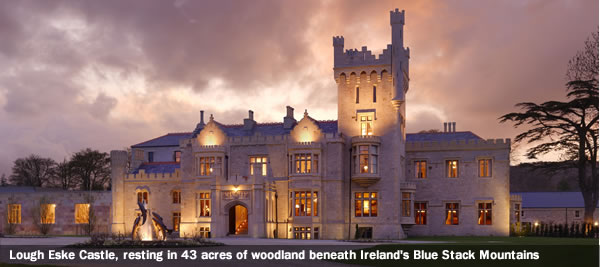Eske means ‘fish’ in Irish. Apt then, that Lough Eske Castle has its own ‘Char’ fish, an almost unique local delicacy. You may need to wait until the start of November for the fishing mayhem to begin, but when the Char rise for about four weeks of the year, there are only a few lakes in the world where they can be found. Char fishing is a talent it seems only the locals have, though it’s worth a brisk walk to watch them in action.
Your journey in through these winding hills and frequent forests leads to Lough Eske Castle, situated in 43 acres of woodland, just under Donegal’s Blue Stack Mountains. Ireland’s Lough Eske Castle is steeped in history that sinks deep into your bones with all the dreamy green meadows and rain danced rivers of an idealised Irish film set.
Explore the woodlands and you’ll find bronze sculptures, like the breadcrumbs dotting a in the fairy tale narrative. Rather than leading back to a gingerbread house, they lead to the graceful and generous hospitality of the Castle. No grumpy witches just warm fires and cosy rooms.
The Castle and surrounding land has changed substantially over centuries. In the middle ages it was owned by the tribal and regal O’Donnell family. A portion of their ruined homestead is still visible to the northern side of the Castle.
The O’Donnell’s held court in Donegal for 133 years; in 1607 their reign came to an end with the ‘Flight of the Earls’ from Rathmullen – probably the first instance of Irish people taking a long holiday in France. Before going, the family partially destroyed Donegal Castle to prevent the English from using it, much like the Irish still do with Guinness.
The O’Donnell’s castle and land were then given to an English Captain, Basil Brooke, who lived in there before moving to Lough Eske. In 1861, the new Lough Eske Castle was built on the site of the Brooke mansion. General George White bought the estate in 1884.
Major General Henry White loved the area so much that he requested to be buried close to the lake. Seemingly a strange request for an Englishman, his wish was granted, and you can visit the plot where he was buried. From a distance it is a reasonably non-descript plot, buried behind trees and over grown foliage, but as you get nearer it becomes obvious that this was extravagant for its time. ‘Beware of Death’ is one of the slogans inscribed on his grave, not sure if this is to ward of grave robbers or a hint at his sense of humour; or whether ‘Death’ was the name of his dog.
In the early 20th Century, the Castle edged towards becoming a hotel. Unfortunately, in 1937 a candle set fire to curtains and almost destroyed the castle completely. Fire crews had to come from the City of Derry, hours away, and by the time they got there the damage was done. Locals claim the castle was haunted after that, more to do with lying derelict and looking eerie than anything else, no one perished in the fire.
Years later, during the Celtic Tiger boom in Ireland, Solis Lough Eske Castle was emerged. This would have been at a considerable expense given that a plaster at that time would have been earning 2000 euro a week and 750 euro for a basic labourer. Even given the sheer cost, no stone was left uncared for.
The baronial façade was returned to its original state, the phallic-like turret of previous owners still stands tall. The rooms, the garden suite in particular, are a home-from-home, with the warmth of under-floor heating and freshly baked wheaten bread on arrival. Each day the staff leave a taster from the locality; home-made apple pie is a favourite, complete with a rolled up scroll of the recipe should you wish to recreate the experience.
The interior is a luxurious warren of rooms, nooks and crannies, for you to forget time and bathe in a good book accompanied by the smell of turf seeping through. There is a Gallery Bar and Lobby Lounge, while the Doak Bar hides further into the castle, probably where Lucien Freud would have reclined – two of his great paintings are monumental in the hallway. It’s said the Castle is haunted; if it is, and it’s Lucien doing the haunting, you can sleep soundly knowing he usually slept with his subjects; though you’ll have some explaining to do if your portrait appears in the hallway.
The Castle’s Cedars Restaurant produces flavoursome local food. Try the Crispy Donegal Pork Belly or the Irish Sirloin, grass fed from cattle under 30 months. And after you’ve walked off dinner, the spa promises to be ‘a special place to restore body and soul’, with a wide range of treatments available – I recommend the back massage, although be prepared to be sorer coming out than when you went in. The spa has a fully equipped thermal suite and an infinity pool; and the gym also state of the art, should you feel the need for extra endurance.
Lough Eske, for all its refined opulence, is a place to get close to nature, though not so close that you forget that a foot spa and glass of champagne wait for you after your weary legs have carried you back to a room fit for an Earl.
Contact the Editor Responsible for this Story:
Brian Maguire – brian.maguire@europeanbusinessexpress.com
Follow us on Twitter: @ebxnews
Facebook: EBX News
